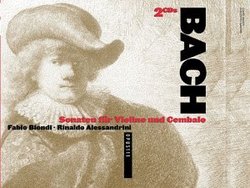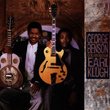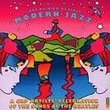| All Artists: Bach, Fabio Biondi, Rinaldo Alessandrini Title: Violin Sonatas Bwv 1014-1019 Members Wishing: 1 Total Copies: 0 Label: Opus 111 Release Date: 4/11/2000 Album Type: Import, Original recording reissued Genre: Classical Styles: Chamber Music, Historical Periods, Baroque (c.1600-1750), Classical (c.1770-1830), Instruments, Strings Number of Discs: 2 SwapaCD Credits: 2 UPC: 709861020164 |
Search - Bach, Fabio Biondi, Rinaldo Alessandrini :: Violin Sonatas Bwv 1014-1019
CD DetailsSimilarly Requested CDs
|
CD ReviewsStunning! Giordano Bruno | 04/29/2004 (5 out of 5 stars) "This is a reissue of Opus 30127 recorded in 1995. Baroque violinist Fabio Biondi and harpsichordist Rinaldo Alessandrini perform the six sonatas for violin and obbligato harpsichord by Johann Sebastian Bach (1685-1750)."Besides being a virtuoso musician, Fabio Biondi is a showman. His entrance in the opening sonata, in which his violin emerges magically from the harpsichord's foreground harmony, is a marvelous foretelling of this performer's ability to draw us in and keep us there. Biondi treats these six sonatas, which receive far too little respect from violinists, as full-fledged concert performance pieces, giving them the full measure of his impressive technique." (David Vernier - amazon.com, at the time of the original release)" Yes! As Wonderful as I Expected... Giordano Bruno | Wherever I am, I am. | 03/29/2009 (5 out of 5 stars) "...from Biondi and Alessandrini, two thorough musicians as well as craftsmen on their respective instruments! What's good about it? They're on the same page. They share the same sensibilities about the music. They have synchronicity of tempi and unanimity of phrasing. In jazz terms, they 'comp' each other.
The harpsichord has major advantages over the modern piano for performing these trio sonatas. (Yes, they are trio sonatas, and they may well have had a continuo line for gamba or cello originally, which is subsumed in the very independent left hand of the keyboardist.) The chief advantage is that the plectra of the harpsichord give a cleaner, more precise attack than the hammers of the piano. The piano fills in too much resonance; the harpsichord is transparent enough to let the right and left hands be heard independently. The icy tinkle of the harpsichord can either penetrate or reveal the warm bread timbre of the gut-strung violin. Biondi plays his fiddle with a stunning array of mannerisms, no doubt, and clearly emphasizes the Italian nature of these Corelli-influenced sonatas. Most importantly, he knows the difference between big notes and little notes. He tosses off the flourishes and ornaments of his line with proper nonchalant bravura, and he finds the big notes that expose the melodic character of the line. Sonata 3, for example, is composed around phrases and fragments of the chorale "Jesus Joy of Man's Desiring." Have you ever heard that fact in any performance on modern violin and piano? Most modern fiddlers over-play the little fast notes as if all the interest of the music were in mere mechanics of the fingers. Biondi's tuning is also impeccable, which separates him from the recording of these sonatas by Lucy van Dael, and his tone is full of variety and affect, which distinguishes him from Rachel Podger. On these pieces, Biondi's handling of 'double-stops' is very sonorous and mellow, and outside the capability of a modern violin with metal strings and a Paganini bow. The modern fiddle sounds like a musical saw on double stops. There is a legendary performance of these six sonatas by Reinhard Goebel and Robert Hill; I imagine it must be wonderful, and wonderfully different, but I haven't heard it and I think it's not available. This recording IS available, and for a reasonable price, on amazon France. It's well worth the extra shipping cost." |



